El Banco Occidental de México
The concession for a bank in Sinaloa was granted to Roberto R. Symon, Celso Gaxiola and Livingston R. Gordon on 13 September 1897. The Banco Occidental de México was founded on 11 January 1898, by George R. Douglas, José Maria Zebada, Livingston R. Gordon, Roberto R. Symon, Celso Gaxiola and Federico Goodchild together with the Western Banking Company of Mexico Limited and some associates of Mazatlán, Manuel Herrerías, Pedro Echeguren, José H. Rico, Victoriano Siordia, Juan Escutia and Antonio de la PeñaASIN, Francisco C. Alcala, Mazatlán, 14 August 1889, f. 119. Details from Aguilar A., Gustavo and Ibarra Escobar, Wilfrido, "Surgimiento de la Banca Regional: El Banco Occidental de México en Sinaloa 1898-1911" in Memoria del XVII Simposio de Historia y Antropología, Hermosillo, 1994. The bank opened its doors on 29 January 1898Memoria de las Instituciones de Credito, 1897-1899. Or earlier, on 13 January (The Mexican Herald, 15 September 1900).
In 1897 the shareholdings wereAGNES, Francisco C. Alcalde, Mazatlán, 7 November 1899:
| shares | |
| The Western Banking Company of Mexico Limited | 4,000 |
| Roberto R. Symon | 500 |
| George R. Douglas | 100 |
| José María Zebada | 100 |
| Federico Goodchild | 100 |
| Celso Gaxiola | 100 |
| Livingston R. Gordon | 100 |
| 5,000 |
The bank originally met with some difficulties on account of the lack of capital, until the middle of 1899 when a strong syndicate of rich merchants of the port of Mazatlan was formed, which bought up all the stock of the bank and proceeded to reorganize it, so in 1899 the shareholdings were:Cole O., (1996), Apuntes para la historia, Banco Occidental de México, 1897-1981. Rota Impresos Nueva Galicia.
| Ordinary shares |
Paid-up shares |
|
| Manuel Herrerías | 1,050 | 960 |
| Pedro Echeguren | 900 | 720 |
| Hemández, Mendía Sucesores | 850 | 680 |
| Guillenno Haas de la Vega | 700 | 560 |
| Wohler, Bartning Sucesores | 300 | 320 |
| Víctor Patrón Hemández | 300 | 240 |
| Somellera Hermanos | 200 | 160 |
| Elorza. Lejarza y Compañía | 170 | 136 |
| José H. Rico | 150 | 120 |
| Bernardo Huthoff | 100 | |
| Marcelino Herrerías y Compañía | 50 | 40 |
| Baldomero Herrerías | 50 | 40 |
| Herbert W. Felton | 50 | |
| George R. Douglas | 50 | |
| Federico Goodchild | 50 | |
| Antonio de la Peña | 30 | 24 |
| 5,000 | 4,000 |
The paid-up capital of the bank then amounted to $250,000, which was naturally considered as too small to carry on the affairs of a bank which had to do the business of the Pacific coast. The bank had been founded with a nominal capital of $500,000 which had to be increased by $100,000 to manage the branch bank at Guaymas. Although the banking laws required only a paid up capital of 50 per cent, the executive decided to pay the whole amount, but even this capital was considered too small for the needs of the bank and on 9 August 1900 a special general assembly decided to increase the amount to $1,500,000The Mexican Herald, 15 September 1900.
The bank also faced problems from the Banco Nacional de México. On 25 March 1901, Carlos Varona, director of the Banco Nacional de México, admitted to Secretario de Hacienda Limantour that he had told the Mazatlán branch not to accept Banco Occidental notes from federal offices because of the large quantities that the Customs were presenting and the fact that the latter bank had just received its $500 notesCEHM, Fondo CDLIV Colección José Y. Limantour, 2a. 1901, carpeta 6, legajo 21946 letter 25 March 1901 and CEHM, Fondo CDLIV Colección José Y. Limantour, 2a. 1901, carpeta 6, legajo 21949 letter 29 March 1901.
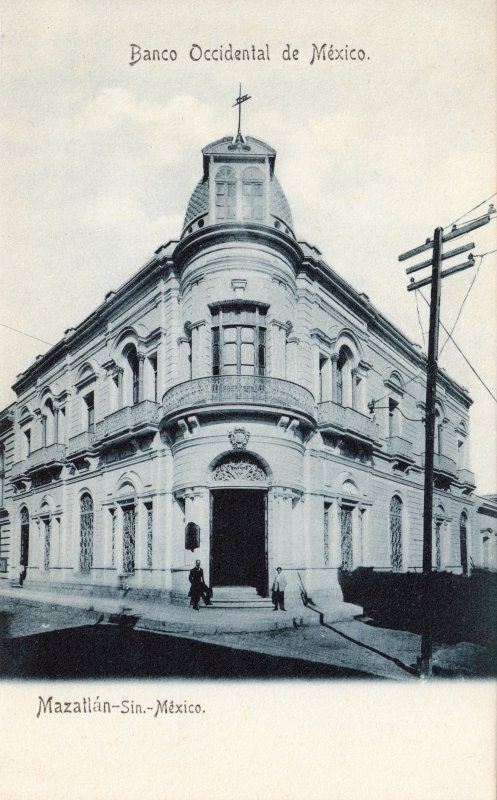
The bank's headquarters were on the corner of calle Principal and calle Constitución. On 18 December 1900 the substitute governor Juan B. Rico, by decree núm. 23[text needed], exempted the bank from property taxes on its new offices and declared that its notes were to be accepted as legal tender in all the state offices.
The bank opened an agency in Culiacán, which was managed by Ismael M. Ruiz from 4 February 1898 until 30 July 1900, and then by José H. Salazar, who held the post until 1912ASIN, Celso Gaxiola Rojo, Culiacán, 22 August 1889, f. 16. Ruiz moved in August 1900 to open the bank’s branch in ColimaEl Tiempo, 23 August 1900, where he stayed until July 1902, being replaced by Luis H. HoyosASIN, Francisco C. Alcala, Mazatlán, 31 July 1902, f. 32.
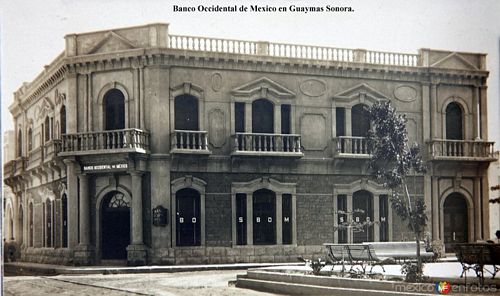
Guaymas branch
The bank set up a branch in Guaymas, Sonora in March 1900. On 7 February the bank’s manager, Alejandro Valdez Flaquer, had appointed Horacio Bonzi as its manager with an annual salary of $4,200 and a houseASIN, Francisco C. Alcala, Mazatlán, 7 February 1900, f. 79. In 1903 it built new premises which it moved into on 18 January 1904Semana Mercantil, 2a Epoca, Año XX, Núm. 13, 28 March 1904. By November 1905 the bank had an agency in Hermosillo under the management of Cipriano AlvarezEl Centinela, 18 November 1905. In Alamos T. Robinson Bours y Hermanos were also agents for the Banco Occidental.
On 29 December 1915 Carranza's Comisión Reguladora e Inspectora de Instituciones de Crédito decided that the bank was within the requirements of its concession and could continue operating. Under Obregón's decree of 31 January 1921 the bank was placed into Class A (for banks whose assets were greater than their liabilities) and allowed to resume all customary operations except the issue of bank notes. The bank was finally liquidated in 1930.
American Bank Note Company print runs
The American Bank Note Company produced the following notes. In January 1898 it engraved special vignettes of a Mexican lady (C 224) and of the port of Mazatlán (C 657) and in February 1900 vignettes of the Aztec calender (C 759) for the $500 note and of the statue of Cuauhtémoc in the Paseo de la Reforma (C 758)This was created on the initiative of Vicente Riva Palacio who proposed to promote the "Porfiriato" regime of president Porfirio Díaz with a monument to honour the last of the Mexica rulers. To do this, a public competition was held and the winner was engineer Francisco M. Jiménez who was inspired by the details of prehispanic Mexican architecture, such as the ancient buildings of Uxmal, Mitla and the archaeological site of Palenque, among others. Jimenez died two days after the decision was announced: therefore the construction of the monument was overseen by Ramón Agea, architect and engineer of the National Palace of Mexico. The Minister of public works, Carlos Pacheco Villalobos, then commissioned Miguel Noreña for sculptures on the monument.
The foundation stone was laid on 5 May 1878 a date chosen by Díaz in recognition of the Battle of Puebla and it was opened nine years later on 21 August 1887 by Díaz.
The monument is topped by a statue of Cuauhtémoc, wearing ceremonial clothing with a penacho (plumed headdress) and holding a spear. The costume and the anatomical arrangement of Cuauhtémoc - made to resemble statues of the Greco-Roman tradition, following the artistic fashion of the time. The tilmàtli (outer garment) is knotted the Roman style, for example.
Designed by Francisco Jiménez, the base of the monument incorporates many Mesoamerican stylistic elements. for the $1,000 note.
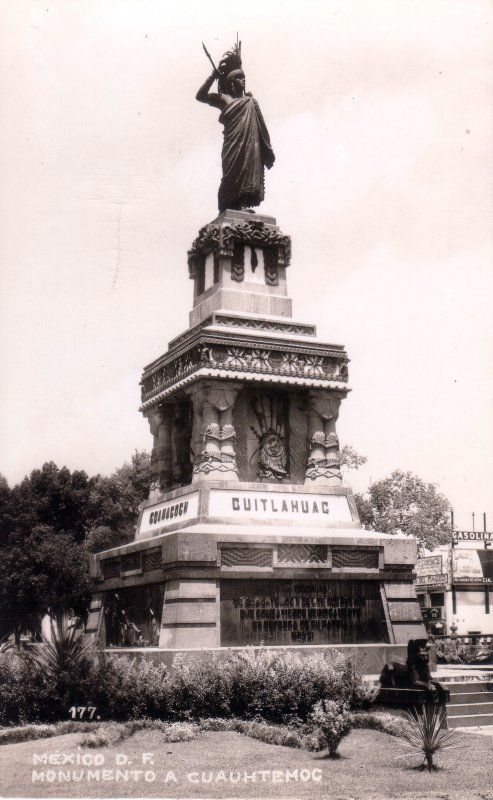
monument to Cuauhtémoc
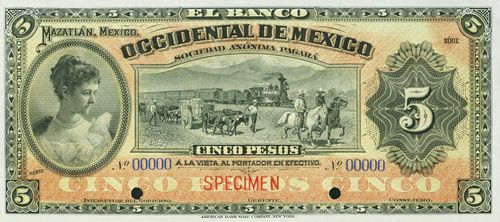
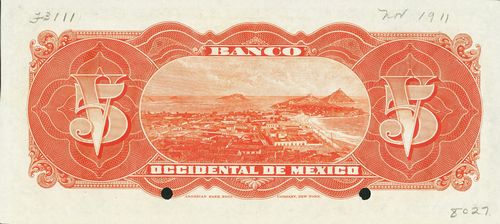
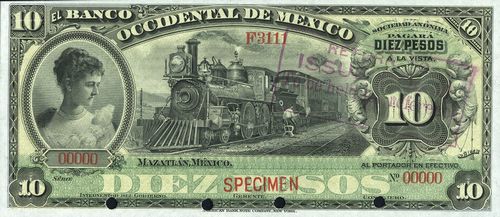
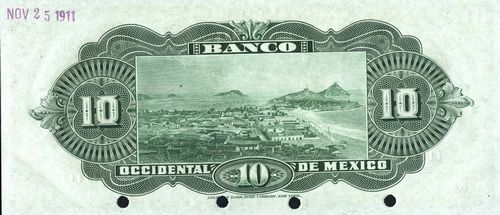
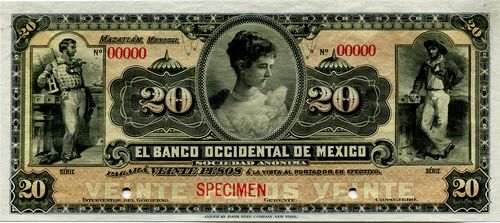
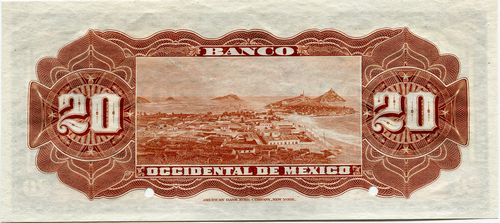
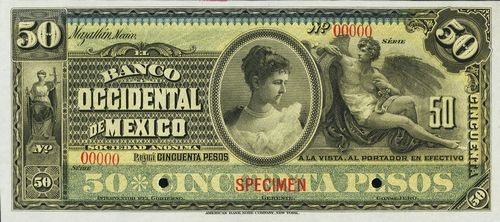
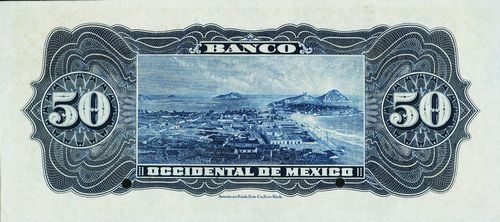
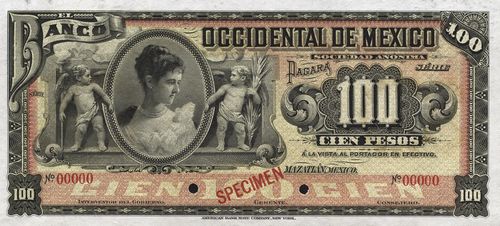
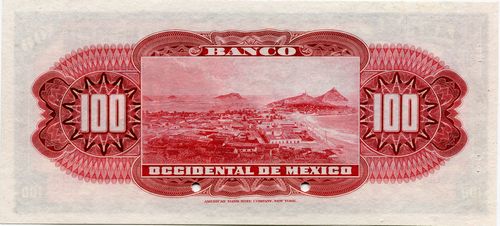
| Date | Value | Number | Series | from | to |
| January 1898 | $5 | 30,000 | 1 | 30000 | |
| $10 | 15,000 | 1 | 15000 | ||
| $20 | 10,000 | 1 | 10000 | ||
| $50 | 2,000 | 1 | 2000 | ||
| $100 | 1,500 | 1 | 1500 |
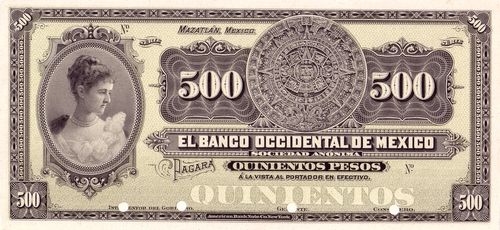
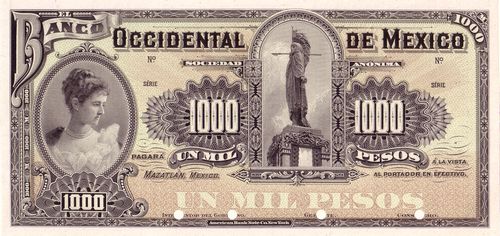
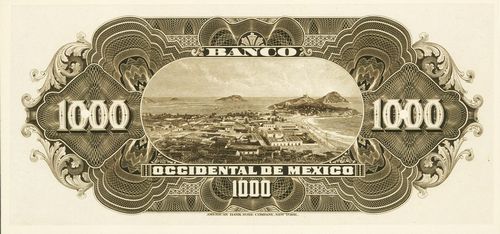
| Date | Value | Number | Series | from | to |
| February 1900 | $5 | 30,000 | 30001 | 60000 | |
| $10 | 15,000 | 15001 | 30000 | ||
| $20 | 7,500 | 10001 | 17500 | ||
| $50 | 3,000 | 2001 | 5000 | ||
| $100 | 2,500 | 1501 | 4500 | ||
| $500 | 200 | 001 | 200 | ||
| $1000 | 100 | 001 | 100 |
| Date | Value | Number | Series | from | to |
| July 1903 | $5 | 100,000 | 60001 | 160000 | |
| $10 | 50,000 | 30001 | 80000 | ||
| $20 | 15,000 | 17501 | 32500 | ||
| $50 | 8,000 | 5001 | 13000 |
On 20 January 1909 the bank’s manager, Alejandro Valdes Flaquer, sent the ABNC three $5 notes, two of which were not in their original colour, as he thought there might have been a falsification. However, the company’s Physico-Chemical Laboratory replied that they were genuine, but had been subjected to the action of sulphur. This had been done either intentionally, with a view to more easily screening out the colours and thus being able to photograph the key plate, or unintentionally, as for instance, through having it in one’s possession while on a visit to sulpher springs, or placing it with sulphur matches in one’s pocket, etcABNC, folder 1055 Banco Occidental de México (1909-1931).
On 13 July 1911 the bank asked for a price of a new issue of 130,000 notes, and on 21 July the ABNC gave a price of $3,248.33 U.S. Gold, F.O.B. New York. On 4 October the bank asked whether for that price it could not supply a better quality paper and so, on 28 October the ABNC sent four specimens of its bank note paper (J. M. #25, 27, 28 and 29) as it only used one type of paper, but in different thicknesses. On 14 November the bank replied that “J.M. 29 strikes us at first hand as being the best, but the question arises whether the thicker paper will stand the constant hard wear to which our notes are subjected, these people being as fond of doubling them up, with the result that in time they split into four parts. #27 would perhaps be more resistant, but we think that we had better leave the final choice in your hands.” The ABNC agreed to use J.M. 27.
The bank wanted the facsimile signatures of the Presidente, Gerente and Consejero printed in New York, and sent examples, but on 27 December, regreted to report that the Secretaría de Hacienda had refused to allow this.
| Date | Value | Number | Series | from | to |
| November 1911 | $5 | 100,000 | 160001 | 260000 | |
| $10 | 20,000 | 80001 | 100000 | ||
| $20 | 10,000 | 32501 | 42500 |
These notes took some time, as the ABNC had to make some new places, so on 1 July 1912 the bank telegraphed that it was much in need of the new notes and wanted to know when they would be ready. Finally, on 18 July the ABNC made a part consignment (20,000 $5 (160001-180000), 20,000 $10 (80001-100000) and 10,000 $20 (32501-42500), forwarding them to the Banco Central Mexicano, Mexico City, per S. S. “Seguranca”. On 15 August the company completed the order (80,000 $5 (180001-260000)), again on the S. S. “Seguranca”.
The plates used in printing the notes were destroyed on 17 July 1931The plates were:
1 – 8 on $5 face plate ‘#2 made on order No. F 3111
2 – 1 on $5 tints, Nos. 1 & 2 made on order of 21 January 1898
1 – 8 on $5 back plate ‘#2 made on order No. F 3111
1 – 4 on $10 face plate ‘#2 made on order No. F 3111
2 – 1 on $10 tints, Nos. 1 & 2 made on order of 21 January 1898
1 – 4 on $10 back plate made on order of 21 January 1898
1 – 4 on $20 face plate made on order of 21 January 1898
2 – 1 on $20 tints, Nos. 1 & 2 made on order of 21 January 1898
1 – 4 on $20 back plate made on order of 21 January 1898
1 – 4 on $50 face plate made on order No. F 264
2 – 1 on $50 tints, Nos. 1 & 2 made on order of 21 January 1898
1 – 4 on $50 back plate made on order No. F 264
1 – 1 on $100 face plate made on order of 21 January 1898
2 – 1 on $100 tints, Nos. 1 & 2 made on order of 21 January 1898
1 – 1 on $100 back plate made on order of 21 January 1898
1 – 1 on $500 face plate made on order of 10 July 1900
2 – 1 on $500 tints, Nos. 1 & 2 made on order of 10 July 1900
1 – 1 on $500 back plate - made on order of 10 July 1900
1 – 1 on $1000 face plate made on order of 10 July 1900
2 – 1 on $1000 tints, Nos. 1 & 2 made on order of 10 July 1900
1 – 1 on $1000 back plate made on order of 10 July 1900.
